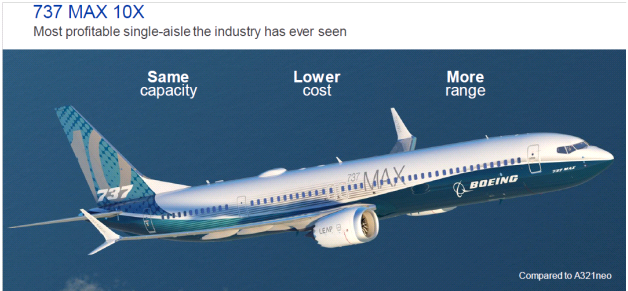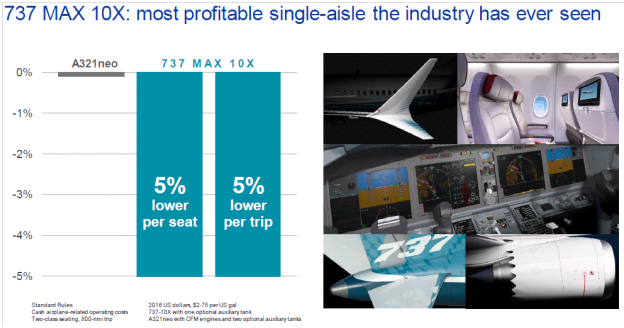Leeham News and Analysis
There's more to real news than a news release.
Boeing 737 MAX 10 analyzed
By Bjorn Fehrm
Note: Boeing’s “soft launch” of the 737-10 MAX at the ISTAT conference in San Diego a week ago met with some sharp criticism by lessors and some others. Within hours, Boeing scheduled a conference call for reporters the next day to defend and promote the airplane. LNC closely tracked the development of the MAX 10 and its competivitive position vis-a-vis the Airbus A321neo. Here is our first detailed, public analysis of the MAX 10.–Editor.
Subscription Required
Introduction
March 12, 2017, © Leeham Co.: Boeing has taken the wraps of the 737 MAX 10. Its overall configuration has long been known to LNC, but we now have more data and performance claims that we can analyze.
Boeing claims the MAX 10 flies farther, cheaper and with just about the same numbers of passengers as the class-leading Airbus A321neo. We now have enough data to analyze if this is true. We put the data in our performance model and here is the result.
We now have enough data to analyze if this is true. We put the data in our performance model and here is the result.
Summary:
- Boeing’s claims on a basic level seem OK. The seating is close to the A321neo.
- On a higher level it starts to stutter. Our model can’t agree on the 5% better economics.
Discussion
737 MAX 10
Boeing finally presented the 737 MAX 10 at the ISTAT 2017 US conference in San Diego last week. The company put forward several claims in the presentation. The MAX 10 would fly about the same number of passengers farther and cheaper than the Airbus A321neo, officials said (Figure 1).
As we presented here, the 737 MAX 10 is a MAX 9 which has fuselage plugs of a total of 66 inches inserted ahead and aft of the wing. Engines and wing are the same.
The main landing gear wheels are moved aft, to give a rear fuselage rotation clearance similar to the MAX 9. This is done by changing from a telescopic main gear strut to a trailing link type. The trick is to find the place to stow a trailing link gear in the 737 wheel well.
Cabin space
Boeing claims the MAX 10 will be within a couple of seats of the A321neo. The seat row cabin length difference is given as 15 inches (door to door difference) (Figure 2). As the cabins have different taper at front and rear and slightly different exit placements (configuration is the same), we built real cabins to check the claims.
We built the two cabins using our normalized Domestic two-class rule-set. The cabins have 16 Domestic First class seats, four abreast with 36 inch pitch. To this, we added the number of six abreast seats at 32 inch pitch that would fit.
A 32 inch pitch in economy is generous with today’s slim-line seats, but it’s the accepted comparison standard and allows comparisons with previous generations of 737 and A320 aircraft. We took care to have the same number of lavatories and serving trolleys (CARTs) in the configurations. The A321neo uses the new, more efficient Cabin-Flex door and Space-Flex rear galley configuration. Cabin-Flex will be available from 2019.
Figure 3 shows the result. The 737 MAX holds three seats (a half row) fewer than the A321neo. Both cabins have four lavatories and 13 meal trolleys.
NOTE: It has been pointed out that we could have chosen a more efficient configuration for the A321neo. We could have used two over-wing exits and blocked the third door pair. It would have filled the cabin attendants seats at the third door in the floor plan. The A321neo then takes 16+180 seats = 196 seats. One can also use the same configuration for the MAX 10. Due to the service doors (fore and aft, on the right side) being of lower exit rating than Airbus doors, the cabin then can only be equipped with 189 seats.
We would agree with Boeing’s claim, the cabins are about equal size. Part of the three seat difference comes from the Airbus using slim-line lavatories in the back, of which two can combine to a PRM (Person with Reduced Mobility) lavatory. Boeing uses standard domestic size lavatories.
If an airline equips the MAX 10 with three slim-line lavatories in the back (of which two could form a PRM lav.), the difference in available cabin length to house seat rows would be almost nil.
In maxium density configuration the Airbus would hold 10 more seats than the MAX 10. Exit limits are 240 seats for the A321neo versus 230 seats for the MAX 10. But one would have to go to 28 inch pitch to have 230 seats being a limit. At practical seat pithces the MAX 10 limit of 230 seats will be OK.
MAX 10 flies farther and cheaper
The claim that a MAX 10 would fly farther and cheaper, we have to classify as aircraft OEM marketing rhetoric (Figure 4).
Both aircraft have about the same range when sensibly equipped. The A320 series wing holds about an ACT’s (Auxiliary Center Tank)-worth of less fuel. So Boeing justly equipped the A321neo with two ACTs and the MAX 10 with one. This means both aircraft are just passing 3,200nm without becoming limited by the fuel amount.
Which of the two who then flies on the longest depends on where Boeing put the final Max Take-Off Weight. When modeled with a reasonable increase (around 5,000lb), they both run out of operational max range (with a 100% load factor cabin and ACTs as above) after 3,200nm. So we would say that on maximum range with passengers and their bags the aircraft seems about equal.
The same goes for operational costs. Our model shows them to be close on this dimension as well. We can’t see in our model the claimed 5% better seat and trip cost for a 737 MAX 10.
Summary
If Boeing decides to go ahead with the MAX 10, it will have a credible alternative to the standard A321neo. The MAX 10 will have worse field performance (essentially the same as MAX 9, which is a bit of a ground hog), but for airlines serving large airports at reasonable altitudes, it will be OK.
For airlines with the 737 MAX as their standard single aisle aircraft, the MAX 10 is certainly more competitive than a MAX 9, given a reasonable net price. The only problem is that the MAX 10 represents what the MAX 9 should have been in the first place. Boeing should have taken its time to define the 737 MAX product range more thoroughly. Two thirds of the product range (the MAX 7 and 9) was not right, as witnessed by sales. The remake brings a fix, but it’s a late brush up.






Hello Bjorn
MAX10 is then a nice derivative.
It remains to see a what cost (design, manufacturing, weight and maintenance) the new MLG will come
For 195 PAX A321 wil probably need only one overwing + door3 (it remains to see what type it assigned)
The same for 737-10MAX. on the 737-900ER below 189, Main cabin Exit can be deactivitad.
Do you believe it is possible to have a 737-9 Short Field with the 737-10 Gear ?
It seems that 737-900Er have slides on the overwing exits, it might no longer be tied to the original gear height
Any clues on the Turn Around Time of a bulk loaded 737-10 vs a CLS loaded a321 ?
Best regards
Re the MAX 9 short field (or improved field performance really, not stellar today) the introduction of the trailing link gear has some structural consequences. As the wheels are no longer vertical to the strut, each touchdown introduces a nose down tipping moment to the gear attachments in the wing. So you need a re-stressed wing which brings weight, which is a loss of passengers for normal airfields. Not sure the customers want that.
To my knowledge all 737 use the flaps as slides, that is also the main reason why the main gear was not raised on the MAX. You change the whole escape certification basis.
Hello Bjorn
I tripled checked, no escape slides on 737-900ER wings…
I had misread an EASA document I guess…
Sorry
Surely the essential difference remains that, from 2019, any A321neo can be an “LR” and, having removed the ACTs, there is no OEW penalty against a non LR according to Airbus. In which case, all A321neo operators can take advantage of a 4,000 nm range as and when they need it – something 737-10MAX operators will not be able to enjoy.
Correct, that is why we don’t agree the MAX 10 flies farther. It does in std with no ACTs, as the A321neo is fuel limited since several hundred nm then. And you could argue that a lot of airlines will use the A321neo without ACTs. Put in ACTs and the A320 variants fly to their MTOW limits. But ACTs cost weight, money and maintenance, so practically all airlines will operate the MAX 10 (if produced) without ACTs. It gets fuel limited very late, you gain very little.
The LR variant comes at a price. If not all A321 after 2019 would be ordered as LRs, they aren’t.
The bottom line, as we conclude, is that the MAX 10 is Boeing’s move to make the top end of the MAX range acceptable. To stop defections, which introduces A320 technology into all 737 airlines. As such it would have been more successful if available from the start.